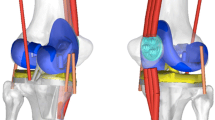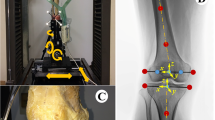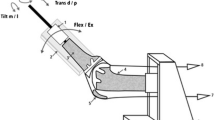Abstract
The purpose of this study was to investigate the influence of tibial base plate angulation on knee kinematics and kinetics during knee arthroplasty. The amount of quadriceps force required to extend the knee and the anteroposterior displacement of a mobile bearing insert as well as tibiofemoral position were measured during an in vitro simulation of an isokinetic knee extension cycle. Human knee specimens (n = 7, mean age 62, range 52–75 years, all male) were tested in a kinematic knee simulating machine after total knee arthroplasty (TKA) with a mobile bearing insert prosthesis (Interax®, Stryker/Howmedica). During simulation, a hydraulic cylinder applied sufficient force to the quadriceps tendon to produce an extension moment of 31 N m about the knee. The quadriceps load was measured using a load cell attached to the quadriceps tendon, the anteroposterior displacement of the mobile bearing insert as well as the relative tibiofemoral position was measured using an ultrasound base motion analysis system (CMS 100®, Zebris). Quadriceps load, insert and tibial displacement were first investigated with the tibial base plate implanted with a neutral tibial base plate orientation, and subsequently after 10° posterior angulation. The quadriceps forces needed to produce a 31 N m knee extension moment after TKA with neutral slope reached levels as high as 1,391 N (SD 82 N). After applying a posterior slope of 10°, maximum quadriceps force was measured to be up to 1,303 N (SD 34 N, P = 0.04). The mobile bearing insert was observed to move up to 0.1 mm (SD 4.2 mm) anteriorly relative to the tibial base plate with neutral tibial slope, and up to 1.0 mm (SD 4.5 mm, P = 0.47) with tibial slope. Femoral position relative to the tibia moved from a posterior position of 13.1 mm (SD 4.0 mm) anteriorly up to 0.5 mm (SD 6.3 mm), and from 16.0 mm (SD 6.4 mm, P = 0.67) to 9.5 mm (SD 9.9 mm, P = 0.33) with a 10° tibial slope. Posterior slope of the tibial base plate resulted in a more physiologic insert movement with a more posterior position of the femur and reduced quadriceps force especially in knee flexion angles above 60° compared to TKA with a neutral slope of the tibial base plate. Thus, the data suggest that the quadriceps lever arm was improved, which might have positive effect in mobilization of patients after TKA.




Similar content being viewed by others
References
Andriacchi TP (1988) Biomechanics and gait analysis in total knee arthroplasty. Orthop Rev 17:470–473
Andriacchi TP, Alexander EJ, Godman SB (1999) Understanding the role of functional adaptions in patients with total knee replacements. 1, 50–53. International Conference on Knee Replacement 1974–2024, IMechE Headquarters. Westminster, London, UK
Andriacchi TP, Galante JO, Fermier RW (1982) The influence of total knee-replacement design on walking and stair-climbing. J Bone Joint Surg [Am] 64:1328–1335
Berman AT, Bosacco SJ, Israelite C (1991) Evaluation of total knee arthroplasty using isokinetic testing. Clin Orthop 271:106–113
Dennis DA (1998) Proposed advantages of posterior cruciate ligament retention orthopaedics today 1[September/October], 10. New Jersey, Slack Incorporated
Dorr L, Scott R, Ranawat CS (1985) Controversies of total knee arthroplasty: importance of retention of the posterior cruciate ligament. In: Ranawat C (ed) Total knee arthroplasty: techniques, results and complications. Springer, Berlin, Heidelberg New York pp 197–202
Dorr LD (1988) Functional comparison of posterior of posterior cruciate retaining versus cruciate sacrificed total knee arthroplasty. Clin Orthop 236:36–41
Draganich LF (1984) The influence of the cruciate ligaments, knee musculature and anatomy on knee joint loading. University of Illinois at Chicago
Garg A, Walker PS (1990) Prediction of total knee motion using a three-dimensional computer-graphics model. J Biomech 23:45–58
Giffin JR, Vogrin TM, Zantop T, Woo SL, Harner CD (2004) Effects of increasing tibial slope on the biomechanics of the knee. Am J Sports Med 32:376–382
Godest AC, de Cloke CS, Taylor M, Gregson PJ, Keane AJ, Sathasivan S, Walker PS (2000) A computational model for the prediction of total knee replacement kinematics in the sagittal plane. J Biomech 33:435–442
Hernigou P, Deschamps G (2004) Posterior slope of the tibial implant and the outcome of unicompartmental knee arthroplasty. J Bone Joint Surg Am 86-A:506–511
Komistek RD, Dennis DA, Haas B (1999) Motion in LCS Rotating Platform. 1, 246–249. London, UK, Imech E. International conference on knee replacement 1974–2024. 22-4-0099
Komistek RD, Dennis DA, Walker SA, Anderson DT (1998) A multicenter analysis of A/P translation in TKA. 11th conference of the ESB, Toulouse
Komistek RD, Walker SA, Crossett LS, Running D, Dennis DA (1998) In vivo kinematics of PS implanted knees during gait. 11th Conference of the ESB, Toulouse
Lewandowski PJ, Askew MJ, Lin DF, Hurst FW, Melby A (1997) Kinematics of posterior cruciate ligament-retaining and -sacrificing mobile bearing total knee arthroplasties. J Arthroplasty 12:777–784
Nisell R, Ekholm J (1985) Mechanics of the knee. Acta Orthop Scand Suppl 216:1–42
Ostermeier S, Hurschler C, Stukenborg-Colsman C (2004) Quadriceps function after TKA—an in vitro study in a knee kinematic simulator. Clin Biomech (Bristol, Avon) 19:270–276
Rand JA (1994) Current concepts review: the patellofemoral joint in total knee arhtroplasty. JBJS 76-A:612–620
Stukenborg-Colsman C, Ostermeier S, Hurschler C, Wirth CJ (2002) Tibiofemoral contact stress after total knee arthroplasty comparison of fixed and mobile-bearing insert designs. Acta Orthop Scand 73:638–646
Stukenborg-Colsman C, Ostermeier S, Wenger K, Wirth CJ (2002) Relative motion of a mobile bearing insert after total knee arthroplasty—a dynamic in vitro study. Clin Biomech 17:49–55
Walker PS, Sathasivam S (1999) The design of guide surfaces for fixed-bearing and mobile-bearing knee replacements. J Biomech 32:27–34
Wimmer MA (1999) Wear of the polyethylene component created by rolling motion of the artificial knee joint. Shaker, Aachen
Wimmer MA, Andriacchi TP (1997) Tractive forces during rolling motion of the knee: implications for wear in total knee replacement. J Biomech 30:131–137
Acknowledgements
We thank the company Stryker/Howmedica®, Limerick, Ireland for their financial support of this study.
Author information
Authors and Affiliations
Corresponding author
Rights and permissions
About this article
Cite this article
Ostermeier, S., Hurschler, C., Windhagen, H. et al. In vitro investigation of the influence of tibial slope on quadriceps extension force after total knee arthroplasty. Knee Surg Sports Traumatol Arthrosc 14, 934–939 (2006). https://doi.org/10.1007/s00167-006-0078-x
Received:
Accepted:
Published:
Issue Date:
DOI: https://doi.org/10.1007/s00167-006-0078-x




